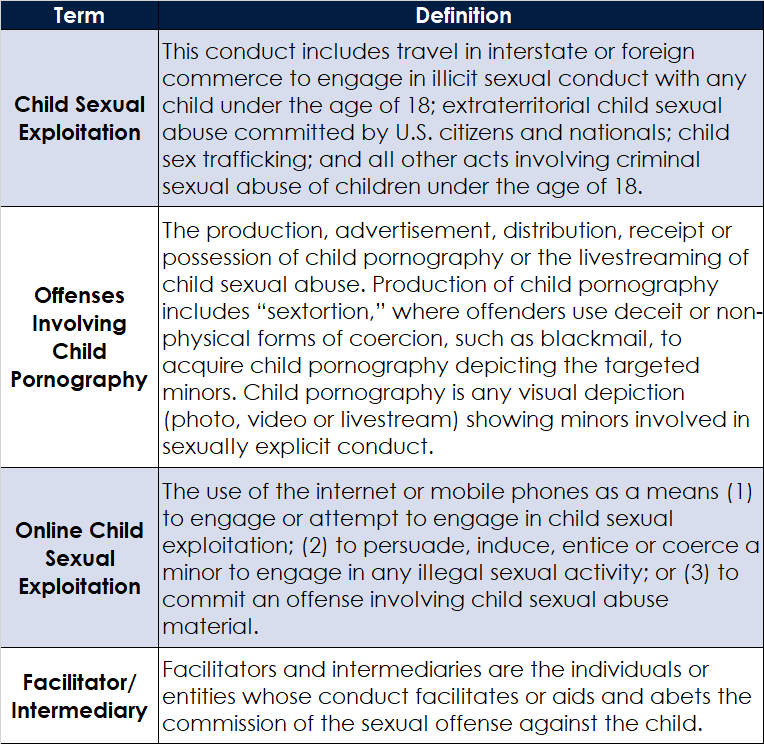
Human trafficking is notably one of the most horrendous crimes that financial crime professionals must consider when monitoring suspicious activity within their anti-money laundering (AML) program. While many financial institutions recognize human trafficking as a growing concern within their communities, some continue to focus on the cross-border aspect of this crime. The COVID-19 pandemic has changed many aspects of everyday life. Human slavery and exploitation are at an epidemic level. This includes child exploitation. The U.S. Department of State's “2021 Trafficking in Persons Report”1 sends a strong message that the COVID-19 pandemic, climate change and enduring discriminatory policies and practices disproportionately affect individuals that are already oppressed by injustices. COVID-19 has made a bad situation worse, and we must be more vigilant in our pursuit of individuals who participate in human trafficking.
The public's isolation and internet usage have increased online predators' opportunities to exploit the vulnerable or naive, making this crime a good source for criminals to retain anonymity. The Financial Crimes Enforcement Network (FinCEN) understands the seriousness of this growing crime, as evidenced by the inclusion of human trafficking as one of the eight national priorities issued on June 30, 2021.2
The Department of Homeland Security (DHS) generally defines human trafficking as a crime against a person involving the use of force, fraud or coercion to obtain some labor or commercial sex act.3 Despite the general and purposefully broad nature of this definition, many are unaware that anytime a minor is involved in a commercial sex act, it will fall under human trafficking by law.
Online Child Sexual Exploitation During COVID-19
Human trafficking and child exploitation are closer to home than most people think. These crimes affect communities all around the country, both in large cities and small rural communities. On September 15, 2021, FinCEN released a notice calling attention to online child sexual exploitation (OCSE).4 The statement emphasizes that these crimes, including funding, production and distribution of child sexual abuse materials, have increased during the COVID-19 pandemic. Factors contributing to the increase include:
- “Increased internet usage by children who are spending more time online, both unsupervised and during traditional school hours...
- “restricted travel [and isolation] during the COVID-19 pandemic resulted in more sex offenders being online...
- “increased access to and use of [more sophisticated encryption] technology...”5 and anonymized transactions.
FinCEN reported that between 2017 and 2020, OCSE-related suspicious activity report (SAR) filings increased 147%, including a 17% increase in 2020 from the previous year.6 In addition, the report indicates that sextortion is also rising among child victims groomed or coerced “into exchanging sexual images via the internet, mobile devices, and social media platforms”7 in exchange for money. Blackmail is often used in these situations.
Identifying Offenders and Victims
Any crime committed via a computer is cybercrime. By collaborating with cybersecurity units within financial institutions, AML professionals can be more effective at gathering information to identify OCSE offenders and victims. Statistics8 from the FBI indicate that thousands of children become victims of crime every year, whether through kidnappings, violent attacks, sexual abuse or online predators. As a result, FinCEN issued new SAR filing instructions for OCSE crimes to assist law enforcement wherever possible.
The following are some of the instructions provided by FinCEN.
- Use the keyword "OCSE-FIN-2021-NTC3" in SAR field 2 (the filing institution’s note to FinCEN).
- "OCSE-FIN-2021-NTC3" should also be referenced in the narrative.
- Select SAR Field 38(z) (Other) for the associated suspicious activity type to link the suspicious activity reported and the OCSE activity. In addition, include the term "OCSE" in the text box.
- If this information is available, enter the subject's internet-based contact with the financial institution in SAR Field 43 (IP address and date).
- Financial institutions should also select SAR Field 38(h)(Human Trafficking), if human trafficking is suspected, in addition to OCSE activity.
- Using Child Sexual Exploitation (CSE) terms and definitions in the narrative section of the SAR is recommended.
The following is a table with CSE terms and definitions from FinCEN’s notice.9
Table 1: CSE Terms and Definitions

Cyber indicators: “When reporting OCSE-related activity, the inclusion of relevant technical cyber indicators [in the narrative section] (e.g., chat logs, IP addresses, email addresses, filenames and CVC addresses, such as bitcoin) are invaluable to locate and investigate criminal's”10 perpetrating activity and thus critical to law enforcement.
Conclusion
Human trafficking is a heinous offense and a blight on our communities, particularly sexual crimes against children. Yet, despite what most people would want to believe, it is happening right under everyone’s noses. It could happen to anybody’s acquaintance, neighbor or family member. Rapidly changing technology and increased online presence within all demographics contribute to the growth of this type of crime and sadly, these factors will not be going away. Financial institutions and AML professionals are the first line of defense against this type of crime. They must stay diligent in detecting and reporting these crimes to help save our children from these predators.
According to a National Human Trafficking Hotline report, many transactions associated with human trafficking intersect with financial institutions.11 Professionals working in financial intuitions should not underestimate the ability of their team to make a difference and possibly save lives. FinCEN has issued excellent human trafficking red flag indicators in their 201412 and 202013 advisories. The consolidated red flag checklist is a great training tool for AML and front-line staff, and it is available for download.14
If you have immediate information to share with law enforcement, do not hesitate to get in touch with the National Center for Missing and Exploited Children at the Cyber Tip hotline at 1-800-843-5678. The hotline partners with the FBI, DHS and other law enforcement agencies, so your information will be funneled to the proper authorities.
Terri Luttrell, CAMS-Audit, board member, ACAMS Central Texas Chapter, compliance and engagement director, Abrigo
- “2021 Trafficking in Persons Report,” U.S. Department of State, https://www.state.gov/reports/2021-trafficking-in-persons-report/
- “Anti-Money Laundering and Countering the Financing of Terrorism National Priorities,” Financial Crimes Enforcement Network, June 30, 2021, https://www.fincen.gov/sites/default/files/shared/AML_CFT%20Priorities%20(June%2030%2C%202021).pdf
- Ibid.
- “FinCEN Calls Attention to Online Child Sexual Exploitation Crimes,” Financial Crimes Enforcement Network, September 16, 2021, https://www.fincen.gov/sites/default/files/shared/FinCEN OCSE Notice 508C.pdf
- Ibid.
- Ibid.
- Ibid.
- “U.S. Attorney Jay E. Town and the Federal Bureau of Investigation Warn of Online Child Exploitation During COVID-19 Pandemic,” U.S. Department of Justice, April 30, 2020, https://www.justice.gov/usao-ndal/pr/us-attorney-jay-e-town-and-federal-bureau-investigation-warn-online-child-exploitation
- “FinCEN Calls Attention to Online Child Sexual Exploitation Crimes,” Financial Crimes Enforcement Network, September 16, 2021, https://www.fincen.gov/sites/default/files/shared/FinCEN%20OCSE%20Notice%20508C.pdf
- Ibid.
- “The Traffickers,” National Human Trafficking Hotline, https://humantraffickinghotline.org/what-human-trafficking/human-trafficking/traffickers
- “Guidance on Recognizing Activity that May be Associated with Human Smuggling and Human Trafficking –Financial Red Flags,” Financial Crimes Enforcement Network, September 11, 2014, https://www.fincen.gov/sites/default/files/advisory/FIN-2014-A008.pdf
- “Supplemental Advisory on Identifying and Reporting Human Trafficking and Related Activity,” Financial Crimes Enforcement Network, October 15, 2020, https://www.fincen.gov/sites/default/files/advisory/2020-10-15/Advisory%20Human%20Trafficking%20508%20FINAL_0.pdf
- “Human Trafficking Red Flags,” Abrigo, https://www.abrigo.com/resources/human-trafficking-red-flags/










